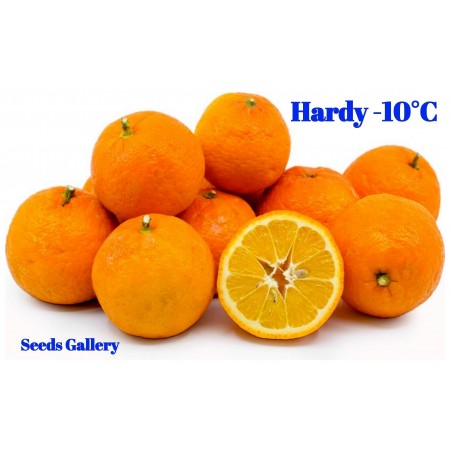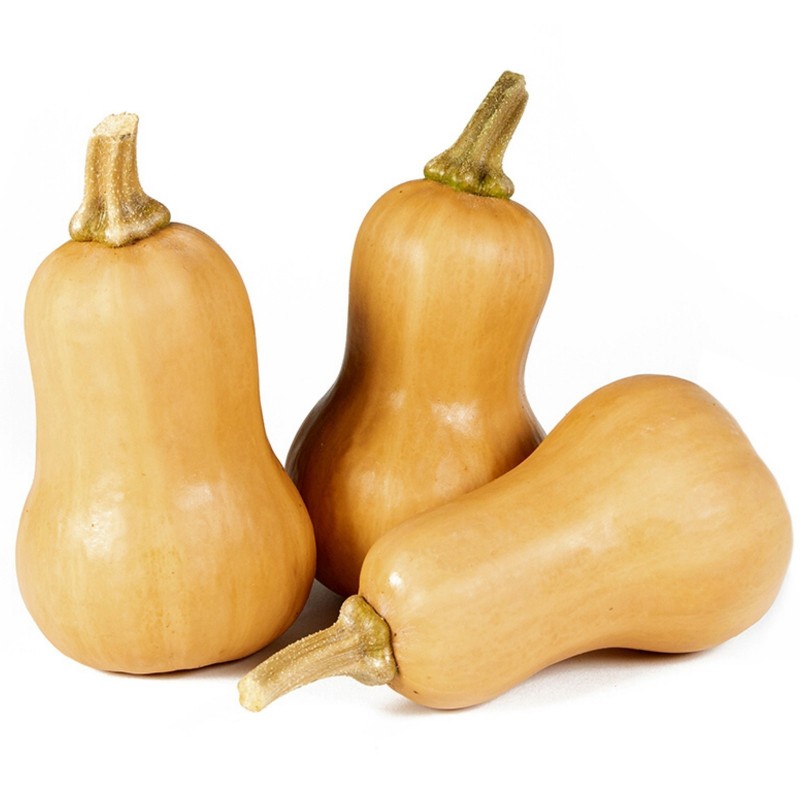
Small Fruited, Mini Butternut Squash Seeds
Small Fruited Mini Butternut Squash Seeds
Price for Package of 5 seeds.
This adorable small-fruited butternut squash has an exceptionally sweet taste perfect for just one or two servings. Compact vines are space-saving for smaller gardens or those who just want to fit more plants
Small Fruited Mini Butternut Squash Seeds
Price for Package of 5 seeds.
This adorable small-fruited butternut squash has an exceptionally sweet taste perfect for just one or two servings. Compact vines are space-saving for smaller gardens or those who just want to fit more plants into the space they have. This is another AAS Winners that is perfect for container gardens and will resist powdery mildew later in the season. Culinary tip: pierce the skin then microwave whole squash for about 12 minutes, cut in half, spoon out the seeds, and enjoy!
| AAS Winner Primary Details | |
| Award: | AAS Vegetable Award Winner |
| Award Type: | National Winner |
| Class: | Squash |
| Variety Name: | Butterscotch |
| Genus: | Cucurbita |
| Species: | moschata |
| Year: | 2015 |
| Common Name: | Butternut squash |
| Type: | Vegetables |
| Breeder: | Seeds Gallery |
| Close Market Comparison: | Early Butternut, Metro |
| Plant Needs | |
| Duration Type: | Annual |
| Light Needs: | Full sun |
| Water Needs: | Normal |
| Season Type: | Warm Season |
| Staking Required: | NO |
| Plant Characteristics | |
| Foliage Color: | Green |
| Plant Habit: | Compact |
| Garden Spacing: | 5-6 square feet per plant (example: 1'x5' or 2'x3') |
| Days To Harvest (Sowing Seed): | 100 days |
| Days To Harvest (Transplant): | 85 days |
| Fruit Color (Harvest): | Tan |
| Fruit Shape: | Butternut with straight neck |
| Fruit Size: | Lenght 15 cm |
| Fruit Weight: | 500-750 g |
| Fruit Flavor Description: | Uncommonly sweet, with nutty undertones and lightly starchy texture |
| The Number Of Fruits Per Plant: | 4 or more |
| Plant Spread: | 3 feet |
| Disease Resistances or Tolerances: | Powdery mildew |
| Home Gardener Use | |
| Container: | YES |
| Herb: | NO |
How to Grow
Transplant: Sow 1-2 seeds in 1 1/2-2” cell-type containers or pots, and thin to 1-2 plants/cell with scissors. Harden plants 4-7 days by reducing fertilizer, water, and temperature, moving flats outside if there is no frost danger. Transplant after frost danger, earlier only if plants are to be covered with floating row covers, about 18” apart. Take care not to disturb roots!
Direct seed: Sow in late spring when soil is at least 70°F (21°C) and weather settled after all frost danger. Sow 2 seeds/ft., 1" deep, in rows 3' apart. Thin plants 24" apart in the row.
Harvest: When stems are drying, fruits have mature color, and skin is hardening, cut stems about 1" from the fruits. Handle fruits very carefully. 1 or 2 light frosts are tolerable, but a hard frost or repeated light frosts will damage fruits.
Curing: To dry and toughen skins, expose fruits to the sun for 5-10 days, covering at night when frost is expected. To cure indoors, expose squash to 80-90°F (27-32°C) with ventilation for 3-5 days.
Storage: Store at 50-55°F (10-13°C) with 50-75% humidity and good air circulation.
Diseases and pests: At time of planting, cover with row cover to protect from insect pests. Control cucumber beetles, squash bugs, and vine borers with azadirachtin or pyrethrin. Control of cucumber beetles early in the season is important, as the insects spread bacterial wilt disease. Prevent disease with crop rotation and good sanitation.
| HEIRLOOM ? | Yes |
|---|---|
| Organic Seeds ? | Organic Seeds |
| Organic/natural ? | Organic/Natural: Yes |
| Edible ? | Edible |
| Pretreatment of sowing ? | Soak in water before sowing 12-24 h |
| Handpicked seeds ? | Handpicked seeds |
| Manufacturer ? | Manufacturer: Seeds Gallery |
| Fruit Weight ? | Fruit Weight : 500 - 1000 g |


Your review appreciation cannot be sent
Report comment
Report sent
Your report cannot be sent
Write your review
Review sent
Your review cannot be sent
🌍 Worldwide Shipping from the EU
We ship worldwide from the European Union using registered air post with signature confirmation on delivery.
📦 Tracking Your Order
Log in to your account and go to Order History > Details to find your tracking number.
You will receive email notifications at every step — please check your spam/junk folder if you don’t see them.
Track your package via:
⚠️ Important Notices
Cash on delivery is not available.
Always provide a valid mobile number with country code when ordering (e.g., +365 456 7686 576).
Do not order to P.O. Boxes or if you cannot be home to sign for the package. We cannot leave parcels with neighbors.
If a package sent to a P.O. Box is lost or undelivered, you lose the right to a refund.
📦 Lost, Returned & Reshipping Packages
For customers in Brazil and Mexico:
We cannot refund packages lost or destroyed by customs.
If your package is returned, we will refund only the product cost — shipping costs are not refundable.
You must pay return postage (€2) and any costs for reshipping.
If a package is returned to us for any reason, you are responsible for paying the return shipping (€2) plus the cost to resend the package.
🚚 Shipment Delivery
Registered shipments require a signature from the recipient.
If your tracking shows the package is still at the origin post office, it means the package is in transit — please contact your local post office directly for updates.
We are not responsible for delivery times and cannot track shipments for you.
📅 Delivery Options & Estimated Times
Delivery Option Processing Time Notes Priority Delivery Ships in 1-7 business days Prioritizes order processing (not guaranteed faster delivery); delays possible during holidays (3-10 days) Secured Delivery Ships in 1-7 business days Available for orders up to €150; refund if lost Standard Delivery Ships in 7-10 business days More economical; delays possible during holidays (7-14 days) Estimated Delivery Time:
Within the EU: 3–20 days
Worldwide: 5–30 days
Example delivery times to the USA:
Delivered in 13, 17, 19, 22, or 27 days.Note: Delivery times depend on your location and the local postal system. COVID-19 may cause additional delays.
💰 Shipping Costs
Shipping and handling fees are calculated automatically during checkout based on the weight of the parcel and the destination country.
⏰ Order Processing Hours
We do not process or ship orders on Saturdays or Sundays.
💳 Payment Options
Bank Transfer (SEPA / IBAN / SWIFT-BIC)
Include your order reference in the payment description (e.g., "SGS-19811702"). Orders without payment within 7 days are automatically cancelled.PayPal
Payments accepted in Euros only. Please select Euros at checkout.Card Payment
For card payments, visit our other site: Exotic Seeds Store
We accept Visa, MasterCard, American Express, CB, Diners Club, Discover, China UnionPay, JCB, and Discover.
⚠️ Transaction Fees
Customers are responsible for any transaction fees. Please provide payment details to help us process your order efficiently.
📢 Final Notes
Before placing your order, please check our website for any special notices, holiday schedules, or specific conditions that may affect your purchase.
Related Products

















